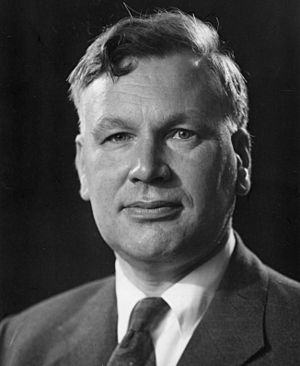Maurice Pryce facts for kids
Quick facts for kids
Maurice Pryce
|
|
|---|---|
 |
|
| Born | 24 January 1913 |
| Died | 24 July 2003 (aged 90) |
| Citizenship | British |
| Alma mater | University of Cambridge Princeton University |
| Known for | Pryce's theorem |
| Awards | FRS (1951) |
| Scientific career | |
| Institutions | Liverpool University University of Bristol University of Southern California University of British Columbia |
| Thesis | The wave mechanics of the photon (1937) |
| Doctoral advisor | Max Born Ralph Fowler |
| Doctoral students | Anatole Abragam David M. Brink Kenneth Le Couteur Marshall Stoneham John Clive Ward John Ziman |
Maurice Henry Lecorney Pryce (born 24 January 1913 – died 24 July 2003) was an important British physicist. He made many contributions to the world of science, especially in understanding how tiny particles work.
Contents
Maurice Pryce's Life
Maurice Pryce was born in Croydon, England. His father was Anglo-Welsh and his mother was French. This meant French was his first language at home! He went to the Royal Grammar School, Guildford as a teenager. After school, he spent a few months in Heidelberg, Germany, to learn German before going to Trinity College, Cambridge.
Studying in America
In 1935, Maurice Pryce traveled to the United States to study at Princeton University. He received a special scholarship called the Commonwealth Fund Fellowship. While there, he worked with famous scientists like Wolfgang Pauli and John von Neumann. He earned his Ph.D. (a high-level university degree) in 1937. His special research topic was about how light particles, called photons, behave like waves.
Working During Wartime
Maurice Pryce returned to England in 1937. He became a Fellow at Trinity College. In 1939, he started working at Liverpool University as a Reader in Theoretical Physics. During World War II, he joined the Admiralty Signals Establishment in 1941. Here, he worked on radar, which is a system that uses radio waves to detect objects.
In 1944, he joined a British team in Montreal, Canada. This team was working on nuclear energy projects, including designing nuclear reactors. After the war ended in 1945, he went back to England. He worked at Cambridge and then at Oxford University in 1946. At Oxford, he became the Wykeham Professor of Physics.
Teaching and Research
Maurice Pryce taught many students who went on to become important scientists themselves. Two of his doctoral students were Anatole Abragam and John Clive Ward. In 1947, he worked with John Ward on a paper about how tiny particles, called quanta, behave when they are linked together, even if they are moving in opposite directions. This idea is known as quantum entanglement.
In 1954, he moved to the University of Bristol and became the head of the Physics Department. Later, in 1964, he moved back to North America. He worked at the University of Southern California and then at the University of British Columbia in 1968. From 1968 to 1978, he helped advise on managing nuclear waste for Atomic Energy of Canada Limited.
Awards and Honors
Maurice Pryce received many awards and honors throughout his career for his important work in physics.
- 1935: Became a Fellow of the Cambridge Philosophical Society.
- 1936: Became a Member of the American Physical Society.
- 1938: Became a Fellow of the Royal Astronomical Society.
- 1946: Became a Fellow of the Physical Society in London. He also served on its Council from 1959 to 1961.
- 1951: Became a Fellow of the Royal Society, which is a very prestigious scientific organization.
- 1957: Became a Member of the Radar and Signals Advisory Board for the Ministry of Supply.
- 1958: Became a Member of the Electronics Research Council for the Ministry of Aviation.
- 1959: Became a Member (and later Chairman) of the Advisory Council for the Royal Military College of Science.
- 1960: Became an Honorary Member of Council for the Société de Physique in Paris, France.
Personal Life
In 1939, Maurice Pryce married Susanne Mararete. She was the daughter of another famous physicist, Max Born, who was also one of Maurice Pryce's Ph.D. advisors.
See also
- Pseudo Jahn–Teller effect

